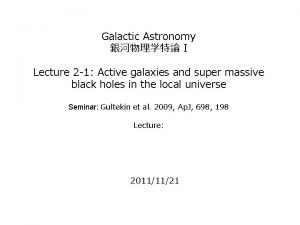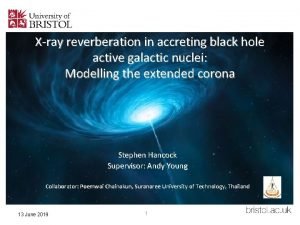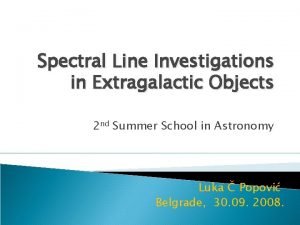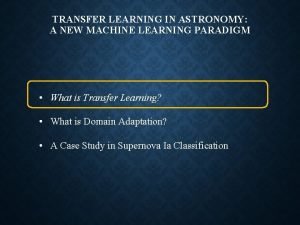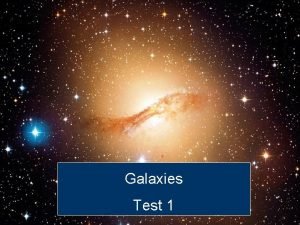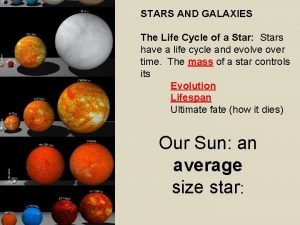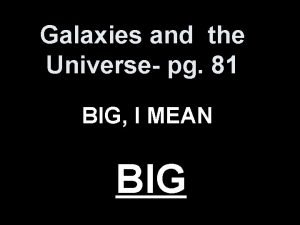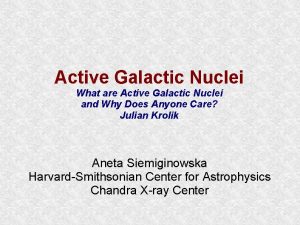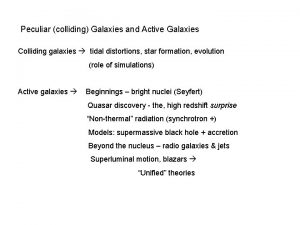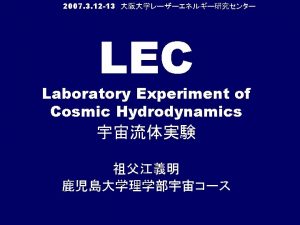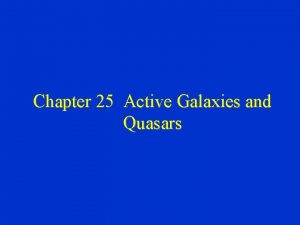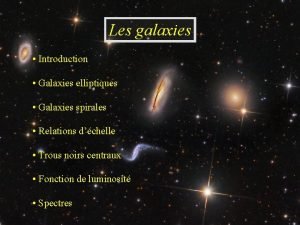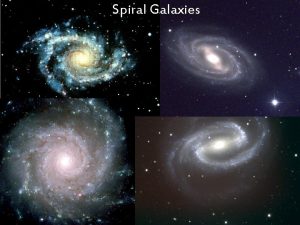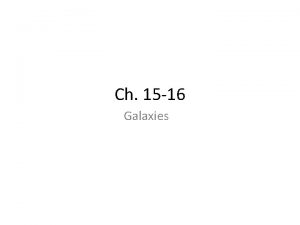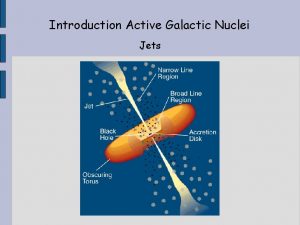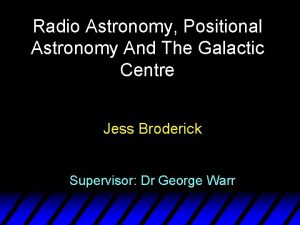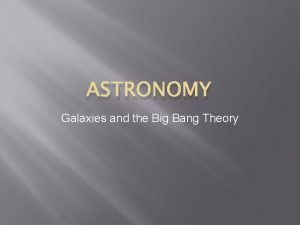Galactic Astronomy I Lecture 2 1 Active galaxies


















- Slides: 18

Galactic Astronomy 銀河物理学特論 I Lecture 2 -1: Active galaxies and super massive black holes in the local universe Seminar: Gultekin et al. 2009, Ap. J, 698, 198 Lecture: 2011/11/21

UV and optical spectra of Active Galactic Nuclei: Seyfert galaxies Permitted emission lines (Ha, Hb, Mg. II, CIII], CIV, NV, Lya etc) of Seyfert 1 galaxies show broad component with FWHM of 2000 -10000 km/s (broad-lines). Forbidden transition lines (禁制線) does not have broad component, because the gas density of the broad-line region is higher than the critical density of the forbidden transitions. Forbidden emission lines as well as permitted ones show narrow emission with FWHM~100 -1000 km/s (narrow-lines). Seyfert 1 Permitted lines: broad+narrow-line Forbidden lines: narrow-line Seyfert 2 Permitted lines: only narrow-line Forbidden lines: narrow-line

Structure of active galactic nuclei: Unified model of Seyfert 1 and 2 galaxies is proposed by Antonucci and Miller (1985, Ap. J, 297, 621) based on the data obtained by spectro-polarimetric observation. Dust torus structure around the nuclei hide the broad-line region of Seyfert 2 galaxies. Emission from the broad-line can be observed through scattered light (though electron or dust scattering). Miller et al. 1980, PASP, 92, 702 Miller and Antonucci 1983, Ap. JL, 271, 7

Structure of active galactic nuclei: NGC 5252 Morse et al. 1998, Ap. J 505, 159 Antonucci and Miller, 1985, Ap. J, 297, 621

Unified model of AGNs: Luminous AGN: QSOs, Less-luminous AGN: Seyfert Radio-loud: Radio-loud QSOs, radio galaxies Radio-quiet: Radio-quiet QSOs, Seyferts From www. cv. nrao. edu/course/astr 534/Extra. Galactic. html

Structure of active galactic nuclei: X-ray data Unified model with the dust torus structure is also supported by the X-ray spectra of Seyfert 2 galaxies. Their X-ray spectra show strong soft X-ray absorption. Awaki et al. 1991, PASJ, 43, 195

Structure of active galactic nuclei: FIR view Seyfert 2 galaxies with Hidden-broad-line region (HBLR) show “hot” MIR-FIR spectra similar to Seyfert 1 galaxies. (Non-HBLR Seyfert 2 galaxies show similar F 25/F 60 to HIIregion, LINER, Starbursts (HLS). Non-HBLRs have lower intrinsic luminosity). Tran 2003, Ap. J, 583, 632

Selecting Seyfert 2 galaxies with optical emission line ratios: AGNs tend to have stronger highly ionized emission lines, like [OIII] Solid line :selection line by Kewly et al. (2001) model calculation, Dashed line : empirical line. Kauffmann et al. 2003, MNRAS, 346, 1055

UV and optical spectra of AGNi: QSOs show similar line properties to Seyfert 1 galaxies, but they are more luminous and their continuum is dominated by nuclear component (not by host galaxy). Richards et al. 2003, Ap. J, 126, 1131

Broad-band continuum of AGNs: QSOs Standard accretion disk (UV) Inverse Compton emission (Xray) from coronal component of surface of the disk. Kawaguchi et al. 2001, Ap. J, 546, 966

AGN and super massive black holes: Black hole massesof AGNs are determined with “reverberation” mapping method. The method measures the time-lag between the time-variation of the fluxes of the nuclear continuum and broad emission lines. The time lag corresponds to the typical distance between the black hole and the line emitting region. The black hole masses can be estimated with the distance and the line width. The lag-velocity diagram suggests the virialized condition of the broad-line region. Peterson et al. 2004, Ap. J, 613, 682

Measuring the black hole mass with stellar motions at the center. VLT/SINFONI observation of velocity field of the central region of Centaurus A. It’s black hole mass is estimated to be 5. 5 x 10^7 Msolar Cappellari et al. 2009, MNRAS, 394, 660

Which is the primary relation ? : Ferrarese and Merritt 2000, Ap. J, 539, L 9

Which is the primary relation ? : MBH-LK relation has rms~0. 3 dex in log. MBH, MBH-Mbulge(=Re*Sigma^2, bulge virial mass) has 0. 25 dex in log. MBH. Marconi and Hunt 2003, Ap. J, 589, L 21

Extending the MBH-Mspheroid relation to the smaller systems: Search for dwarf Seyfert 1 galaxies with SDSS spectro-scopic data. Barth et al. 2005, Ap. J, 619, L 151 Greene & Ho 2004, Ap. J, 610, 722

Extending the MBH-Mspheroid relation to the smaller systems: HST/STIS observation of a globular cluster G 1 in M 31. Its central velocity dispersion is 30 km/s and the estimated black hole mass is MBH=18000 Msolar。 Gebhardt et al. 2005, Ap. J, 634, 1093 Gebhardt et al. 2002, Ap. J, 578, L 41

Extending the MBH-Mspheroid relation to the smaller systems: A search for SMBH at the center of the globular cluster M 15 with HST STIS. If the excess velocity dispersion is explained with existence of SMBH, its mass is edimated to be MBH=3900 Msolar. See next slide. Gerssen et al. 2002, AJ, 124, 3270

Extending the MBH-Mspheroid relation to the smaller systems: Proper motion survey of the globular cluster M 15 with HST WFPC 2. Comparison with N-body simulation (Baumgardt & Makino 2003, MNRAS, 340, 227) suggest that no black hole is necessary for the cluster. The upper limit is 500 Msolar. Mc. Namara et al. 2003, Ap. J, 595, 187
 How are galaxies classified? *
How are galaxies classified? * Learning astronomy by doing astronomy
Learning astronomy by doing astronomy Learning astronomy by doing astronomy
Learning astronomy by doing astronomy Learning astronomy by doing astronomy
Learning astronomy by doing astronomy Active galactic nuclei
Active galactic nuclei Active galactic nuclei
Active galactic nuclei Active galactic nuclei
Active galactic nuclei Machine learning in astronomy
Machine learning in astronomy 01:640:244 lecture notes - lecture 15: plat, idah, farad
01:640:244 lecture notes - lecture 15: plat, idah, farad Type of galaxy
Type of galaxy Era of galaxies
Era of galaxies 4 types of galaxies
4 types of galaxies Life cycle of a galaxy
Life cycle of a galaxy Evolution of galaxies
Evolution of galaxies Chapter 30 galaxies and the universe
Chapter 30 galaxies and the universe Most galaxies in the inner region of a large cluster are
Most galaxies in the inner region of a large cluster are Elliptical, spiral and irregular
Elliptical, spiral and irregular Elliptical galaxies facts
Elliptical galaxies facts Billions of galaxies
Billions of galaxies




